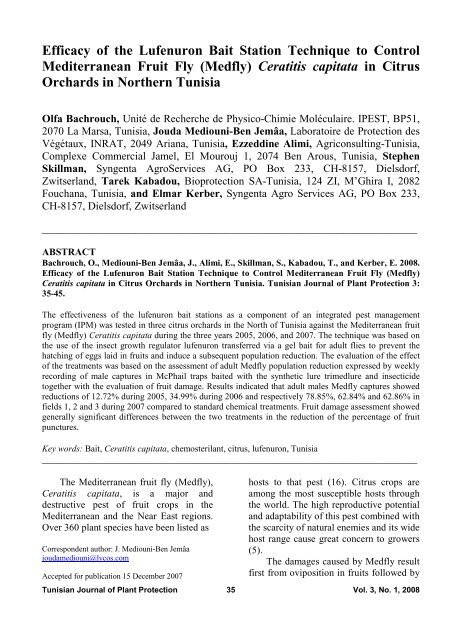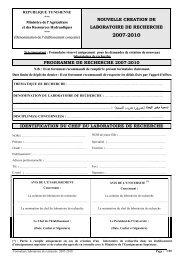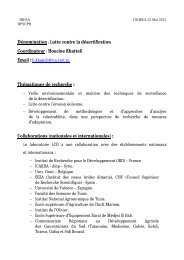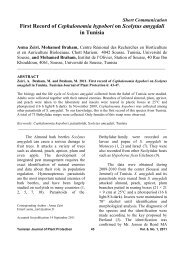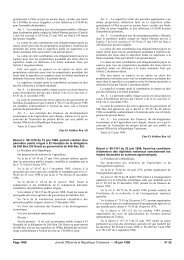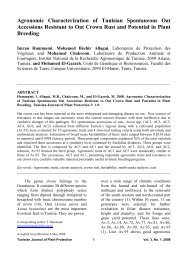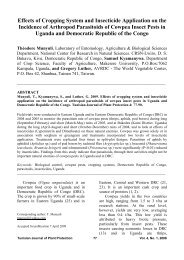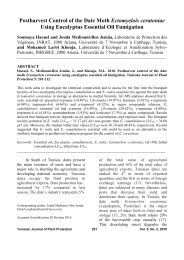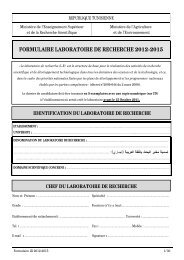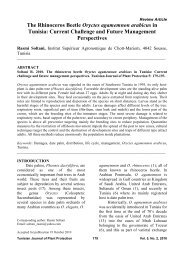Efficacy of the Lufenuron Bait Station Technique to Control ... - Iresa
Efficacy of the Lufenuron Bait Station Technique to Control ... - Iresa
Efficacy of the Lufenuron Bait Station Technique to Control ... - Iresa
Create successful ePaper yourself
Turn your PDF publications into a flip-book with our unique Google optimized e-Paper software.
400Treated<strong>Control</strong>300Male/trap/week20010001 3 5 7 9 11 13 15 17 19 21 23WeekFig. 2. Medfly captures/trap/week in <strong>the</strong> treated and control fields during 2006.100Treated<strong>Control</strong>80Male/trap/week60402001 2 3 4 5 6 7 8 9 10 11 12 13 14 15 16 17 18 19 20 21 22 23WeekFig. 3. Medfly captures/trap/week in <strong>the</strong> first field during 2007.Tunisian Journal <strong>of</strong> Plant Protection 39Vol. 3, No. 1, 2008
400Treated<strong>Control</strong>300Male/trap/week20010001 2 3 4 5 6 7 8 9 10 11 12 13 14 15 16 17 18 19 20WeekFig. 4. Medfly captures/trap/week in <strong>the</strong> second field during 2007.50Treated<strong>Control</strong>40Male/trap/week30201001 2 3 4 5 6 7 8 9 10 11 12 13 14 15 16 17 18 19 20 21 22 23WeekFig. 5. Medfly captures/trap/week in <strong>the</strong> third field during 2007.Tunisian Journal <strong>of</strong> Plant Protection 40Vol. 3, No. 1, 2008
<strong>Lufenuron</strong> effect on puncturingfruit damage. The impact <strong>of</strong> <strong>the</strong>treatments on <strong>the</strong> percentage <strong>of</strong> puncturedfruits was assessed during three years <strong>of</strong><strong>the</strong> study (Table 1). During <strong>the</strong> year 2005,<strong>to</strong>tal means punctured fruits oscillatedbetween 82.75 and 93.3 respectively in <strong>the</strong>treated and control fields (31.25 at <strong>the</strong>beginning and 121 at <strong>the</strong> end <strong>of</strong> <strong>the</strong> trial in<strong>the</strong> treated field against 36 and 134 in <strong>the</strong>control area). No statistical differenceswere obtained. The effect <strong>of</strong> <strong>the</strong> baitstation technique is thus comparable <strong>to</strong> <strong>the</strong>conventional farmer’s treatment.Table 1. Mean punctured fruits at <strong>the</strong> beginning and <strong>the</strong> end <strong>of</strong> <strong>the</strong> trial and <strong>the</strong> overall mean <strong>of</strong> punctured fruits during2005, 2006, and 2007*Year 2005Treated<strong>Control</strong>P valueYear 2006Treated<strong>Control</strong>P valueYear 2007Field 1Treated<strong>Control</strong>P valueField 2Treated<strong>Control</strong>P valueField 3Treated<strong>Control</strong>P valueMean <strong>of</strong> punctured fruits at <strong>the</strong>beginning <strong>of</strong> <strong>the</strong> trial31.25 a36 a0.36241.75 b18.75 a0.0350.5 a0 a0.362.25 b0 a0.040.5 a0 a0.14Mean <strong>of</strong> punctured fruits at <strong>the</strong>end <strong>of</strong> <strong>the</strong> trial121 a134 a0.629.5 b9.5 a0.057.25 a12.5 a0.0631.25 b9.74 a0.0045.5 a7.5 a0.11Overall mean <strong>of</strong>punctured fruits82.75 a93.3 a0.36719.28 b9.40 a0.00073 a4.03 a0.3310.08 b3.06 a0.00012.36 a2.75 a0.59* Within columns, means followed by <strong>the</strong> same letters are not significantly different (P=0.05) according <strong>to</strong> StudentTest.<strong>Lufenuron</strong> effect on <strong>the</strong> percentage<strong>of</strong> damaged fruits. Results shown in Fig.6 revealed that <strong>the</strong> percentage <strong>of</strong> puncturedfruit is comparable between <strong>the</strong> treated andcontrol field each year despite <strong>the</strong> littledifferences observed during <strong>the</strong> first and<strong>the</strong> last year (field 3). Indeed, for <strong>the</strong> year2005, <strong>the</strong> percentage <strong>of</strong> punctured fruitwas 42.9% in <strong>the</strong> treated field against51.1% in <strong>the</strong> control area. Fur<strong>the</strong>rmore,during <strong>the</strong> year 2007, we observed 9.68%<strong>of</strong> fruit damage in <strong>the</strong> treated area against13.14% in <strong>the</strong> control plot.The statistical analyses <strong>of</strong> data during<strong>the</strong> three years (Student Test at P < 0.05)showed no significant differences in <strong>the</strong>percentages <strong>of</strong> punctured fruits between<strong>the</strong> treated and <strong>the</strong> control areas except for<strong>the</strong> years 2005 and 2007 (field 3).Moreover, in <strong>the</strong> treated field, significantdifferences in <strong>the</strong> percentage <strong>of</strong> fruitpunctures were obtained between <strong>the</strong> firstand last year <strong>of</strong> <strong>the</strong> trial. Simultaneously,decreases <strong>of</strong> fruit punctures were observedin <strong>the</strong> control field (Fig. 6).Tunisian Journal <strong>of</strong> Plant Protection 41Vol. 3, No. 1, 2008
6050Treated<strong>Control</strong>Damaged fruit (%)4030201002005 2006 07 Field 1 07 Field 2 07 Field 3Year / FieldFig. 6. Percentage <strong>of</strong> fruit damage in <strong>the</strong> treated and control fields during 2005, 2006 and 2007.DISCUSSIONResults obtained from this studyshowed clearly that <strong>the</strong> lufenuron <strong>Bait</strong><strong>Station</strong> technique could be involved as anappropriate strategy for <strong>the</strong> control <strong>of</strong> <strong>the</strong>Medfly in Tunisia. The Match Traptechnique may <strong>of</strong>fer a viable, efficient andeconomic alternative. It could beincorporated with some <strong>of</strong> <strong>the</strong>se existingmethods in an IPM approach. As reportedin this paper, important reduction <strong>of</strong> <strong>the</strong>insect population and a visible decrease <strong>of</strong><strong>the</strong> percentage <strong>of</strong> fruit damage had beenmade after three years trials in citrusorchards in north <strong>of</strong> Tunisia, comparable<strong>to</strong> standard farmer treatments. It may bethat <strong>the</strong> small size <strong>of</strong> <strong>the</strong> trial plots (1 hasurrounded by citrus orchards) influenced<strong>the</strong> results due <strong>to</strong> influx <strong>of</strong> fertile flies fromsurrounding orchards. Working on largerplots <strong>of</strong> 5 ha, or even several hundredhectares in a wider campaign area, wouldprovide more significant improvements in<strong>the</strong> level <strong>of</strong> control.Evaluations <strong>of</strong> fruit damage werelimited <strong>to</strong> fruit stings. Since lufenuron acts<strong>to</strong> s<strong>to</strong>p eggs hatching and not <strong>to</strong> s<strong>to</strong>pfemale flies from stinging fruits, it ispossible that <strong>the</strong> larval population in <strong>the</strong>fruits decrease. Future trials could includeincubation <strong>of</strong> damaged fruits <strong>to</strong> countpupation and adult emergence <strong>to</strong> detect<strong>the</strong>se effects.Similar work conducted in Spainusing <strong>the</strong> insect growth regula<strong>to</strong>r lufenuronunder two application methods sprayingand hanging traps showed a reduction <strong>of</strong>Medfly population <strong>of</strong> 80.4% in <strong>the</strong> sprayedfield and a reduction <strong>of</strong> 77.6% in <strong>the</strong> solidbait field. Moreover, percentage <strong>of</strong>punctured fruit was 38.8% in <strong>the</strong> innerzone against 68.6% in <strong>the</strong> outer zone (16).Fur<strong>the</strong>rmore, (5) showed that <strong>the</strong> lufenuronused as chemosterilizing agent at a dose <strong>of</strong>Tunisian Journal <strong>of</strong> Plant Protection 42Vol. 3, No. 1, 2008
1,000-ppm against C. capitata leaded <strong>to</strong> animportant sterilizing activity as hatchinginhibi<strong>to</strong>rs. In Morocco, El Moubariki (8)indicated that <strong>the</strong> system Match MedflyRB03 in small plot trials showed anefficacy comparable <strong>to</strong> <strong>the</strong> conventionalchemical control. The rates <strong>of</strong> Medflycaptures and <strong>the</strong> mean number <strong>of</strong> pupaeproduced by punctured fruits were greaterin <strong>the</strong> control field than in <strong>the</strong> treated area.He signaled that this technique could beassociated <strong>to</strong> <strong>the</strong> Sterile Insect <strong>Technique</strong>(SIT) in order <strong>to</strong> be more efficient (forexample in <strong>the</strong> Project Clean Fruit). In thiscase, <strong>the</strong> number <strong>of</strong> released malesrequired would be reduced. Citrus fruitsare an important and valuable exportcommodity for Tunisia but high infestationrates with <strong>the</strong> Mediterranean fruit fly arecausing significant economic losses. Afterthis study promising results are obtainedand <strong>the</strong> lufenuron baiting technique couldbe suggested as an alternative controlmethod in Tunisian citrus orchards.Never<strong>the</strong>less, demonstrations on largerareas are needed <strong>to</strong> fur<strong>the</strong>r improve <strong>the</strong>suppressive potential <strong>of</strong> this technique.Fur<strong>the</strong>r research might focus on <strong>the</strong> doserate and performance in different cropsunder field Tunisian conditions.ACKNOWLEDGEMENTWe would like <strong>to</strong> extend our deepest gratitude<strong>to</strong> Mr Ben Salah Hassine for his support. This workwas partly supported by Syngenta Crop ProtectionAG, Bioprotection S A-Tunisia and Agriconsulting-Tunisia. Thanks are due <strong>to</strong> farmers: MohamedAzaiez, Aslene Cherif, Promag and Somi Sghaeir._____________________________________________________________________________RESUMEBachrouch O., Mediouni-Ben Jemâa J., Alimi E., Skillman S., Kabadou T., et Kerber E. 2008.Efficacité de la technique d’appât au <strong>Lufenuron</strong> dans la lutte contre la mouche méditerranéennedes fruits Ceratitis capitata dans les vergers d'agrumes du Nord de la Tunisie. Tunisian Journal <strong>of</strong>Plant Protection 3: 35-45.L’efficacité du piége à lufenuron en tant que composante d’une stratégie de lutte intégrée a été testéecontre la mouche méditerranéenne des fruits Ceratitis capitata dans trois vergers d’agrumes situés aunord de la Tunisie durant les années 2005, 2006 et 2007. La technique se base sur l’utilisation d’unrégulateur de croissance des insectes, le lufenuron, contenu dans un gel-appât pour empêcher l’éclosiondes œufs pondus dans les fruits et engendrer une réduction ultérieure du niveau des populations de lacératite. L’évaluation de l’effet des traitements a été mesurée par la réduction du niveau des populationsexprimée par le dénombrement hebdomadaire des mâles capturés dans les pièges de type McPhail appâtésavec l’attractif sexuel le trimedlure et l’insecticide et l’évaluation des dégâts sur fruits. Les résultatsindiquent que des réductions du niveau de capture des adultes de la cératite de 12.72% durant 2005,34.99% durant 2006 et respectivement 78.85%; 62.84% et 62.86% dans les vergers 1, 2 et 3 en 2007comparé au traitement chimique conventionnel. L’évaluation de l’infestation des fruits montre desdifférences généralement significatives entre les deux types de traitement dans la réduction dupourcentage des fruits piqués.Mots clés : Appât, Ceratitis capitata, citrus, lufenuron, stérilisant chimique, Tunisie_____________________________________________________________________________Tunisian Journal <strong>of</strong> Plant Protection 43Vol. 3, No. 1, 2008
(Wied.) (Diptera, Tephritidae). Revista Brasileiradi En<strong>to</strong>mologia 28: 421-424.13. Gogi, M. D., Rana M. S., Lloyd, M. D.,Muhammad, J. A., Andrew, B. K., andMuhammad, A. 2006. Effectiveness <strong>of</strong> two insectgrowth regula<strong>to</strong>rs against Bemisia tabaci(Genndius) (Homoptera: Aleyrodidae) andHelicoverpa armigera (Hübner) (Lepidoptera:Noctuidae) and <strong>the</strong>ir impact on populationdensities <strong>of</strong> arthropod preda<strong>to</strong>rs in cot<strong>to</strong>n inPakistan. Pest Management Science 62: 982-990.14. Hendricks, J., Ortiz, G., Liedo, P., and Schwarz,A. 1983. Six years <strong>of</strong> successful Medfly programin Mexico and Guatemala. Pages 353-365.Proceedings <strong>of</strong> <strong>the</strong> CEC/IOBC InternationalSymposium on Fruit flies <strong>of</strong> Economicimportance. November 16-19 1982, A<strong>the</strong>ns,Greece. 642 pp.15. Licudine, J. A., Grant, T. M., Roy, T. C., Liquido,N.J., and Qing, X.L. 2001. <strong>Efficacy</strong> and residues<strong>of</strong> phloxine B and uranine for <strong>the</strong> suppression <strong>of</strong>Mediterranean fruit fly in c<strong>of</strong>fee fields. PestManagement Science 58: 38-44.16. Liquido, N.J., Shinoda, L.A., and Cunningham,R.T. 1991. Host plants <strong>of</strong> <strong>the</strong> Mediterranean fruit(Diptera : Tephritidae) An annotated world list.En<strong>to</strong>mological Society <strong>of</strong> America, MiscellaneousPublications 77: 1-52.17. Navarro-Llopis, V., Juan S.C., Ildefonso, A.,Vic<strong>to</strong>r, C. G., and Eduardo, P.Y. 2004. <strong>Efficacy</strong> <strong>of</strong><strong>Lufenuron</strong> as chemosterilisant against Ceratitiscapitata in field trials. Pest Management Science60: 914-920.18. Rendon, P., Sivinski, J., Holler, T., Bloem, K.,Lopez, M., Martinez, A. and Aluja, M. 2006. Theeffects <strong>of</strong> sterile males and two braconidparasi<strong>to</strong>ids, Fopius arisanus (Sonan) andDiachasmimorpha krausii (Fullaway)(Hymenopera), on caged populations <strong>of</strong>Mediterranean fruit flies, Ceratitis capitata(Wied.) (Diptera: Tephritidae) at various sites inGuatemala. Biological <strong>Control</strong> 36: 224-231.19. Rosseler, Y., Ravins, E., and Gomes, P.J.G. 2000.Sterile insect technique (SIT) in <strong>the</strong> near east, atransboundary bridge for development and peace.Crop Protection 19: 733-738.20. Sivinski, J., Jeronimo, F., and Holler, T. 2000.Development <strong>of</strong> a real releases <strong>of</strong>Diachasmimorpha tryoni (Cameron)(Hymenoptera : braconidae) A parasi<strong>to</strong>id thatattacks <strong>the</strong> Mediterranean fruit fly Ceratitiscapitata Wiedmann (Diptera Tephritidae) in <strong>the</strong>Guatemalan highlands. Biocontrol Science 10: 15-25.21. Steel Robert, G. D. and Torrie, J. H. 1980.Principles and procedures <strong>of</strong> statistics. Abiometrical approach. McGraw-Hill BookCampany, New York, USA. 633 pp.22. Weems, H.V.J. 1981. Mediterranean fruit fly,Ceratitis capitata (Wiedemann) (Diptera :Tephritidae). En<strong>to</strong>mology Circular N o 230. FloridaDepartment <strong>of</strong> Agriculture & Consumer Services.Division <strong>of</strong> Plant Industry, Florida, USA. 12 pp.23. Wendell, W.K. and Ruth, R.P. 1964. Effect <strong>of</strong> <strong>the</strong>chemosterilisant Apholate on <strong>the</strong> syn<strong>the</strong>sis <strong>of</strong>cellular components in developing Housefly eggs.Biochemistry Journal 92: 353-357.----------------------Tunisian Journal <strong>of</strong> Plant Protection 45Vol. 3, No. 1, 2008
Tunisian Journal <strong>of</strong> Plant Protection 46Vol. 3, No. 1, 2008


